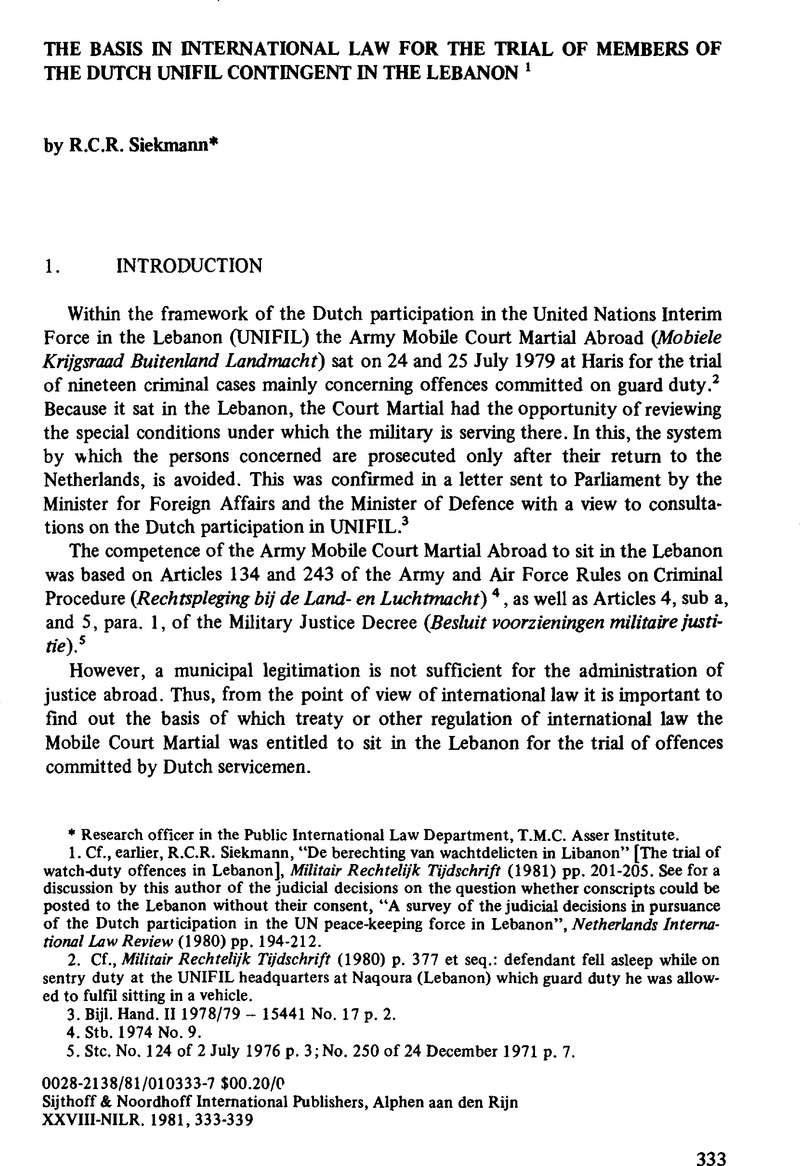No CrossRef data available.
Article contents
The Basis in International Law for the Trial of Members of the Dutch Unifil Contingent in the Lebanon1
Published online by Cambridge University Press: 21 May 2009
Abstract

- Type
- Short Articles
- Information
- Copyright
- Copyright © T.M.C. Asser Press 1981
References
2. Cf., Militair Rechtelijk Tijdschrift (1980) p. 377 et seq.: defendant fell asleep while on sentry duty at the UNIFIL headquarters at Naqoura (Lebanon) which guard duty he was allowed to fulfil sitting in a vehicle.
3. Bijl. Hand. II 1978/79 – 15441 No. 17 p. 2.
4. Stb. 1974 No. 9.
5. Stc. No. 124 of 2 July 1976 p. 3; No. 250 of 24 December 1971 p. 7.
6. Obviously, this is a reference to the original stand-by offer by the Dutch Government dating from the 1960s (1963, 1965) to earmark marines and infantrymen for UN peace-keeping purposes.
7. Bijl. Hand. II 1978/79 – 15441 No. 3 p. 6 para. 13.
8. Convention of 13 February 1946, UNTS Vol. 1 p. 16, Stb. 1948 No. I 224.
9. Reply of 17 August 1979, Aanh. Hand. II 1978/79 No. 1751 p. 3467.
10. UN Doc. S/12611 p. 2 para. 4(b).
11. Since 10 March 1949.
12. Nederland en de vredestaken van de Verenigde Naties [The Netherlands and the peacekeeping tasks of the United Nations] (The Hague 1980) p. 73 et seqGoogle Scholar.
13. Date derived from a Royal Decree of 13 August 1979, Stb. 450.
14. Finally, the following outline gives a full picture of the various stages of decision-making with regard to the Dutch participation in UNIFIL: N.B.:

On 15 March 1979 the Dutch contingent took over the responsibility for the positions of the French batallion that had been withdrawn.
15. The United Nations have neither designated the members of national contingents as officials nor included them in the relevant lists as prescribed in para. 17 of the Convention.
16. UN Doc. A/32/394 of 2 December 1977, Annex II, Appendix I p. 8.
17. Cf., the Report mentioned in n. 10 supra with the UN Secretary-General's report of 27 October 1973 on the implementation of Security Council resolution 340 whereby UNEF II was established, UN Doc. S/11052/Rev. 1, also: Ministry of Foreign Affairs publication No. 107 (The Hague 1975) p. 384.
18. Agreement of 8 February 1957/, UN Doc. A/3256, UNTS Vol. 260 p. 61 et seq., Ministry of Foreign Affairs publication No. 52 (The Hague 1958) p. 132 et seq.
19. Agreement of 27 November 1961, UN Doc. S/5004, UNTS Vol. 414 p. 229 et seq., Ministry of Foreign Affairs publication No. 80 (The Hague 1966) p. 254 et seq.
20. Agreement of 31 March 1964, UN Doc. S/5634, UNTS Vol. 492 p. 57, Ministry of Foreign Affairs publication No. 80 (The Hague 1966) p. 270 et seq.
21. Cf., Martinez, J.-C., “La force interimaire des Nations Unies au Liban”, in: Annuaire franfais de droit international (1978) p. 489Google Scholar; see also, Schumacher, J.G. in: VN te velde [UN in the field], Netherlands Institute for Peace Questions (The Hague 1980) p. 39Google Scholar.
21a. de Lange, J.O., “Peace-keeping operations of the UN and public international law some legal aspects in the Netherlands”. NILR (1981) p. 186Google Scholar.
22. The ADA Report has nothing to say about the legal status of the exchange ot memoranda. Most likely it is a legally non-binding agreement in accordance with the parties' intention. If the Dutch Government had considered it to be a formal treaty, it would have been submitted to the States General (Art. 60(2) of the Constitution). N.B.: The UNEF I and UNFICYP formal (standard) agreements concerning the service of national contingents were concluded by an exchange of letters with the troop-contributing countries. In the agreements (paras. 5–7) the question of jurisdiction was settled by the UN Secretary General who took the initiative for this course of action. (UN Doc. A/3943/Annex I, UNTS Vol. 271 pp. 135, 187, 223; Vol. 274 pp.47, 81,199, 233; Vol. 277 p. 191; Vol. 555 p. 119;Vol. 557 pp. 85, 129.).
23. Cf., in this connection, Ballaloud, J., “L'opération des Nations Unies au Sud Liban (Mars-Octobre 1978)”, in: Revue juridique et politique, indépendence et coopération (1979) pp. 243–244Google Scholar: “Au couts des diverses operations de maintien de la paix, le formalisme initial se traduisant par un véritable ‘accord de base’ entre L'O.N.U. et le gouvernement hôte s'est peu à peu estompé pour faire place à un consentement tacite. Dans la pratique, on peut noter que l'action par les parties intéressées des résolutions des Nations Unies visant l'installation de ces forces suffit à conférer a ces opèrations un caractére consensuel. S'aggisant du Liban, on précisera que la résolution 425 établissant la F.I.N.U.L. fait état de la ‘demande du Gouvernement libanais’. Le Leban a ici exprimé un accord formel, mais il ne semble pas qu'il y ait eu jusq' présent ‘d’ accord de base’ entre l'O.N.U. et le Gouvernement libanais, comme ce fut le cas au Moyen-Orient en 1956, ainsi qu'á Chypre ou au Congo. Sur ce point, la F.I.N.U.L. est conforme a la pratique de la F.U.N.U. (1973) et de la F.U.N.O.D. (1954)”.


